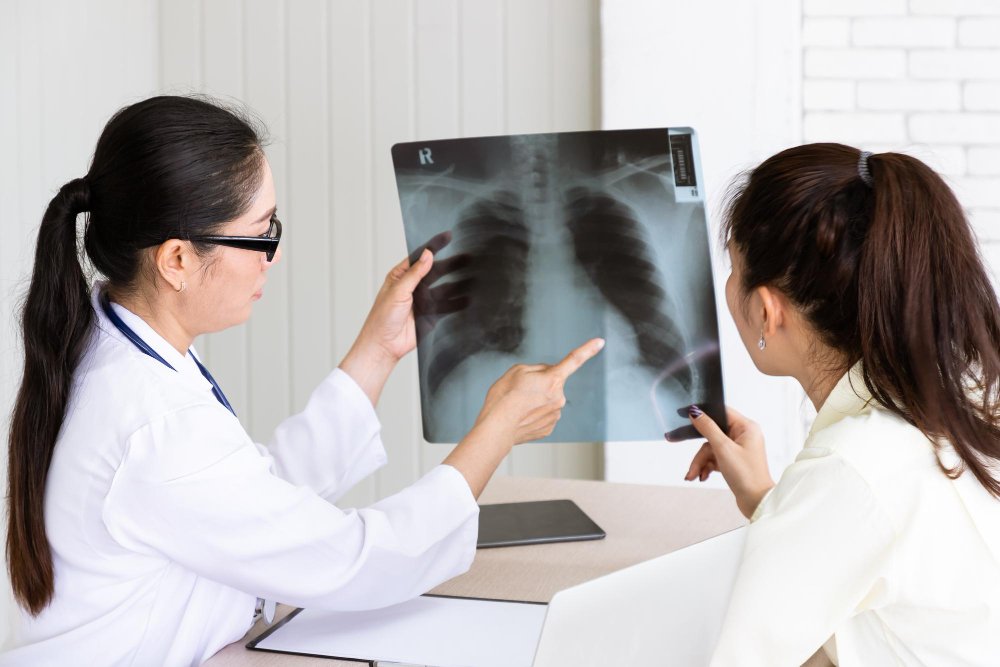Pulmonary fibrosis is a progressive lung disease that affects the tissue deep inside your lungs, making it stiff and scarred. Over time, this scarring (fibrosis) interferes with your lungs’ ability to transfer oxygen into your bloodstream, causing persistent respiratory symptoms.
While the condition can develop slowly, the symptoms of pulmonary fibrosis often become more noticeable and severe over time. Recognising these signs early is crucial for timely diagnosis and better disease management.
Understanding Pulmonary Fibrosis
Pulmonary fibrosis is not a single disease but a group of conditions that cause lung tissue damage and scarring. In healthy lungs, the air sacs (alveoli) are elastic and easily expand when you breathe in. In pulmonary fibrosis, the scar tissue makes them stiff, reducing lung capacity and oxygen flow.
This damage may be caused by:
- Long-term exposure to environmental toxins (dust, asbestos, silica)
- Autoimmune diseases (like rheumatoid arthritis)
- Certain medications or radiation therapy
- Genetic factors
- Unknown causes (idiopathic pulmonary fibrosis)
Regardless of the cause, the symptoms of pulmonary fibrosis are largely similar and tend to worsen over time.
Early Symptoms of Pulmonary Fibrosis
One of the challenges in diagnosing pulmonary fibrosis early is that initial symptoms are often mild and may be mistaken for ageing, lack of fitness, or a lingering infection.
1. Shortness of Breath (Dyspnoea)
Shortness of breath is often the first noticeable sign. At first, you may feel breathless only when:
- Climbing stairs
- Walking uphill
- Engaging in exercise or physical labour
As the disease progresses, even everyday activities like dressing, talking, or eating can trigger breathlessness.
Why it happens:
Scarring in lung tissue reduces elasticity, making it harder for lungs to expand and take in enough oxygen.
- Dry, Persistent Cough
A chronic, hacking cough that does not produce phlegm is another common symptom of pulmonary fibrosis.
- It may be mild at first but can become constant and disruptive.
- The cough often worsens when talking, laughing, or lying down.
Why it happens:
The scarring irritates the lung tissue, triggering a reflex cough.
- Fatigue and Low Energy
People with pulmonary fibrosis often feel unusually tired, even after a good night’s sleep.
- This fatigue is due to low oxygen levels in the blood.
- Daily tasks feel more exhausting as the body works harder to get oxygen.
- Unexplained Weight Loss
- Reduced appetite and increased calorie burning from laboured breathing can cause gradual weight loss.
- This symptom is often overlooked but should be taken seriously.
- Clubbing of Fingers
Clubbing is a change in the shape of the fingertips and nails:
- Fingertips become wider and rounder.
- Nails curve downward.
Why it happens:
Long-term oxygen deprivation causes changes in blood vessels and tissues in the fingers.
Progressive Symptoms of Pulmonary Fibrosis
As lung scarring worsens, the symptoms of pulmonary fibrosis intensify and new complications may appear.
6. Chest Discomfort or Pain
- Some people feel a dull ache or tightness in the chest.
- Pain may be related to strained respiratory muscles or inflammation.
7. Rapid, Shallow Breathing
- The body compensates for poor oxygen exchange by increasing breathing rate.
- Breathing may appear fast but not deep, especially during activity.
8. Bluish Tint to Skin or Lips (Cyanosis)
Caused by low oxygen levels in the blood.
Commonly seen on lips, fingertips, and toes.
9. Swelling in Ankles or Legs
- Pulmonary fibrosis can lead to pulmonary hypertension (high blood pressure in the lungs) and strain the heart.
- This can cause fluid build-up in the lower limbs.
Symptoms During Flare-Ups or Acute Worsening
Some patients experience sudden worsening of symptoms, known as acute exacerbations.
During these episodes, symptoms like breathlessness, coughing, and fatigue intensify rapidly over days or weeks.
Possible triggers:
- Respiratory infections
- Air pollution
- Unknown inflammatory events
If this happens, immediate medical care is essential.
How Pulmonary Fibrosis Symptoms Affect Daily Life
The symptoms of pulmonary fibrosis can significantly impact physical activity, social interactions, and emotional well-being.
- Physical limits: Walking short distances may become tiring, making exercise difficult.
- Emotional effects: Anxiety and depression are common due to reduced independence.
- Sleep disruption: Shortness of breath and coughing can interfere with sleep.
When to See a Doctor
Early medical evaluation is important if you experience:
- Shortness of breath lasting more than a few weeks
- A cough that doesn’t go away
- Unexplained fatigue or weight loss
- Clubbing of fingers
Prompt diagnosis allows early intervention to slow disease progression.
Final Thoughts
The symptoms of pulmonary fibrosis often begin subtly but progress over time, making early detection vital. Shortness of breath, persistent cough, fatigue, weight loss, and clubbing of fingers are key warning signs.
If you or a loved one notice these symptoms, consult a pulmonologist promptly. At the right stage, interventions can help slow the disease, improve lung function, and enhance quality of life.




